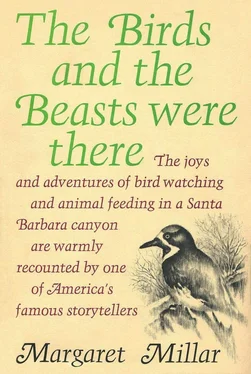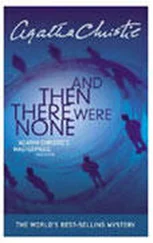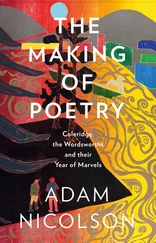Маргарет Миллар - The Birds and the Beasts Were There
Здесь есть возможность читать онлайн «Маргарет Миллар - The Birds and the Beasts Were There» весь текст электронной книги совершенно бесплатно (целиком полную версию без сокращений). В некоторых случаях можно слушать аудио, скачать через торрент в формате fb2 и присутствует краткое содержание. Город: New York, Год выпуска: 1967, Издательство: Random House, Жанр: Природа и животные, на английском языке. Описание произведения, (предисловие) а так же отзывы посетителей доступны на портале библиотеки ЛибКат.
- Название:The Birds and the Beasts Were There
- Автор:
- Издательство:Random House
- Жанр:
- Год:1967
- Город:New York
- ISBN:нет данных
- Рейтинг книги:4 / 5. Голосов: 1
-
Избранное:Добавить в избранное
- Отзывы:
-
Ваша оценка:
- 80
- 1
- 2
- 3
- 4
- 5
The Birds and the Beasts Were There: краткое содержание, описание и аннотация
Предлагаем к чтению аннотацию, описание, краткое содержание или предисловие (зависит от того, что написал сам автор книги «The Birds and the Beasts Were There»). Если вы не нашли необходимую информацию о книге — напишите в комментариях, мы постараемся отыскать её.
The Birds and the Beasts Were There — читать онлайн бесплатно полную книгу (весь текст) целиком
Ниже представлен текст книги, разбитый по страницам. Система сохранения места последней прочитанной страницы, позволяет с удобством читать онлайн бесплатно книгу «The Birds and the Beasts Were There», без необходимости каждый раз заново искать на чём Вы остановились. Поставьте закладку, и сможете в любой момент перейти на страницу, на которой закончили чтение.
Интервал:
Закладка:
Margaret Millar
The Birds and the Beasts Were There
To those of my fellow
bird-watchers who have
completed their life lists:
Adelaide Garvin
Pat Haworth Higginson
Edouard Jacot
Egmont Rett
1
Houdunit
It was the beginning of summer and I was approaching a corner in my life. I did not know that it was waiting for me, let alone that it would be of great significance; and when I turned it, there was no artillery salute, no bands played, no thunder rolled. The only sound was a quick, light tapping that seemed to be coming from the enclosed lanai on the lower floor. I was upstairs in the living room reading a book in an attempt to relax. My husband had left that morning on a trip to Mexico and I was already regretting my decision not to accompany him.
There was no one else in the house, yet the tapping continued. The dogs were lying beside my chair — not to indicate their devotion — so much as to make sure I didn’t go any place without them. Normally they barked at the drop of a decibel half a mile away, but they didn’t stir until I reminded them sharply that they were supposed to be watchdogs. Then, responding to my tone, they started tearing up and down the room in a loud and disorganized demonstration of watch doggedness. By the time they stopped, so had the tapping.
A few minutes later it began again, louder and more purposeful, as if the interruption had served merely to increase the performer’s determination. That a performer existed I had no doubt: the noise didn’t sound mechanical, like air in the plumbing or a defect in the water heater, and the wind wasn’t strong enough to budge a butterfly.
I went downstairs, the dogs at my heels. The rooms — lanai and storage room, piano alcove, my husband’s study and bath — were empty, as expected, and outside there was nothing unusual — no curious child from one of the houses across the canyon, no lost dog or straying cat. As I started back upstairs I heard the tapping again. This time it was closer and I could tell exactly where it was coming from — the window of the bath between my bedroom and my office. The new development wasn’t exactly reassuring since that particular window was fifteen feet from the ground and no nearby tree provided access to it. The added fact that the dogs weren’t making a fuss forced me to conclude that the originator of the noise was not of this world.
Twilight in the empty house did not provide the best occasion for speculating about the spirit world and who, among its occupants, might be trying to get in touch with me. I thought of various relatives and friends, and even my childhood hero, Houdini, who had promised his faithful followers that if he could possibly communicate from the spirit world he would do so on the anniversary of his death. I had to check several reference books before learning that he had died in Detroit, Michigan, the end of October 1926. This was Santa Barbara, California, the end of June. It seemed unlikely that Houdini could have made such a gross mistake, so I crossed him off the list.
The ghostly noise stopped when darkness fell and I heard nothing more until the following morning, shortly after dawn. Once more I searched the house, upstairs and down, inside and out, and found nothing out of the ordinary. But I had no sooner gone out to the kitchen to make breakfast when the tapping started again from one of the east windows of the lanai; it was followed by a series of sounds as if someone was trampling around in the leaf litter underneath the ceanothus shrubs. The eeriest part of the whole thing was that the dogs didn’t react to the sound, though their ears are twenty times keener than mine and they must certainly have heard it. Perhaps the performer was so well known to them that they considered him unworthy of their attention. If this was the case, why hadn’t I seen him? Was my failure due to a deficiency of vision or of perception?
I was finishing breakfast when Bertha Blomstrand, who’d recently built a house across the road, telephoned to ask if I was wide awake enough to come over and see something peculiar. She advised me to make as little noise as possible, which, translated bluntly, meant to leave the dogs at home.
Bertha was waiting for me at the front door. She motioned me to be silent, then led me through the house to a window which looked out on the driveway, where her car was parked. It was a small foreign model, so common it could be seen on any street at any time. The only unusual thing about it was the left rear hubcap, which was being vigorously attacked by a brown bird. The bird would fling himself at the hubcap, beat it with his wings and peck it with such force that we could hear the sound clearly through the closed window. This was not love, like a parakeet seeing himself in a mirror. This was war. The chrome of the hubcap showed the bird a mortal enemy.
Thus the source of the tapping on my windows was discovered, and it was not Houdini whodunit. It was a little brown bird who acquired a name before he even had an identity — Houdunit.
I went back home, relieved that the culprit was nothing more formidable, yet curiously unsatisfied. What species did he belong to? Had he engaged in previous fights with his enemy in the left rear hubcap of Bertha’s car and in the window of the lanai and of the upstairs bathroom? And why only this one hubcap out of four, these two windows out of many?
I had come to the corner and only one step was necessary to take me around it. The step seemed a very small one: later in the morning, when I went to the supermarket for groceries, I bought a thirty-nine-cent box of parakeet seed.
Some kinds of addiction are considered incurable. A heroin addict can be kept off his drug in a prison cell for years but the result is not a cure. A bird watcher can be confined to a room with the blinds drawn and the windows closed tight. But when one of the windows is opened and a snatch of bird song drifts in, when a blind is raised and a small creature wings by, or certain leaves in a tree stir without wind, the addiction is more powerful than ever. It carries with it, however, a lifetime guarantee. Wherever you go in this world — the rain forests of the Amazon, the Arctic tundra, the Mojave Desert, the Swiss Alps, the Taj Mahal, the top of the Empire State Building or the middle of Main Street, Peoria, Illinois — no matter where you find yourself, there’ll be birds to watch and you’ll never again be bored.
I sprinkled half the parakeet seed on the ledge outside the living room. This ledge, which was to become the setting for hundreds of itinerant players to act their comedies and tragedies, was four feet wide and covered with roofing material which provided safe footing. It ran the length of two rooms, some fifteen yards, and had been intended mainly as an overhang for the lanai and patio on the lower level.
Nature had provided the ledge with a varied and colorful backdrop. At one end was a gnarled Australian tea tree, with a grove of ceanothus behind it. Entwined throughout the branches of the ceanothus were the strong, swift runners of a rampaging trumpet vine which had been in bloom since January. At the other end of the ledge we’d built a porch, which quickly became overgrown with cotoneaster and bougainvillaea. In the background an elderberry bush had grown to tree size, and beyond it stood a row of huge Monterey pines. Looking straight out across the ledge from the chair where I generally sat, I could see first a long privet hedge, unclipped and as tall as a man, a lemon tree and some young loquats, a pittosporum forty feet high and almost as wide, a number of old live oak trees and some enormous blue gum eucalyptus.
Our property slanted down about thirty feet to a flat area that had been an access road at one time. Though a previous owner had stuck a few concrete flagstones around it, it wasn’t enough of anything to have a name. We called it the lower terrace only for purposes of identification. From here the ground sloped down into a canyon with a creek at the bottom. This creek, unlike most of the ones in southern California in the summer, had water in it. Its banks were strewn with boulders, and wildly overgrown with mugwort, native blackberry, deadly nightshade and poison oak. This last we made no attempt to get rid of, having learned that a fair-sized patch of poison oak is as good a way to discourage trespassers as a fence and a Keep Out sign. The final backdrop was the Santa Ynez range of mountains, a changing mass of greens and greys and violets depending on the light.
Читать дальшеИнтервал:
Закладка:
Похожие книги на «The Birds and the Beasts Were There»
Представляем Вашему вниманию похожие книги на «The Birds and the Beasts Were There» списком для выбора. Мы отобрали схожую по названию и смыслу литературу в надежде предоставить читателям больше вариантов отыскать новые, интересные, ещё непрочитанные произведения.
Обсуждение, отзывы о книге «The Birds and the Beasts Were There» и просто собственные мнения читателей. Оставьте ваши комментарии, напишите, что Вы думаете о произведении, его смысле или главных героях. Укажите что конкретно понравилось, а что нет, и почему Вы так считаете.



![Маргарет Миллар - Rose's Last Summer [= The Lively Corpse]](/books/384369/margaret-millar-rose-s-last-summer-the-lively-c-thumb.webp)


![Маргарет Миллар - The Iron Gates [= Taste of Fears]](/books/433837/margaret-millar-the-iron-gates-taste-of-fears-thumb.webp)





